Calf Muscle Anatomy: Anatomy and Exercise
Anatomy of the Calf muscle
The calf muscle is located on the back of the lower leg and is actually made up of two muscles:
- gastrocnemius muscle
- soleus muscle
The medial and lateral heads of the gastrocnemius muscle, which is the most superficial, are present. The gastrocnemius muscle belly is formed by the convergence of its two heads. The lateral head arises from the lateral surface of the lateral femoral condyle and the medial head from the posterior, non-articular side of the medial femoral condyle. The muscle belly of the gastrocnemius joins the soleus muscle distally to produce the calcaneal tendon which inserts onto the posterior calcaneus.
The tibial nerve innervates the calf muscle, which plantarflexes the ankle joint. Located deep to the gastrocnemius is the big, flat muscle known as the soleus. Although the plantaris muscle is tiny in size, its tendon part is noticeably lengthy. It is easy to confuse the tendinous section for a nerve. Up to 10% of people lack the plantaris muscle, which originates from the lateral supracondylar line of the femur. The muscle descends medially before finally developing into a tendon that passes between the gastrocnemius and soleus muscles of the leg. The calcaneal tendon merges with this tendon.
GASTROCNEMIUS MUSCLE
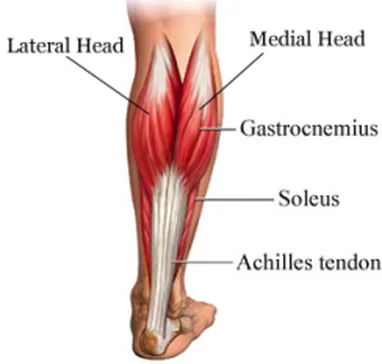
The gastrocnemius muscle is a large powerful muscle. it has 2 heads i.e. medial head and lateral head. This muscle lies superficial to the soleus muscle. The 2 heads of gastrocnemius and soleus are together referred to as gastrosoleus. The gastrocnemius is the larger calf muscle, forming the bulge visible beneath the skin. The gastrocnemius has two parts or “heads,” which together create its diamond shape.
ORIGIN:
- The origin of the medial head of the gastrocnemius is from posterosuperior depression on the medial condyle of the femur and from the capsule of the knee joint.
- The origin of the lateral head of the gastrocnemius is from the lateral surface of the lateral condyle of the femur, the lateral supracondylar line, and from the capsule of the knee joint.
INSERTION:
The tendon of this muscle fuses with the tendon of the soleus to form the tendon Achilles which is inserted into the middle one-third of the posterior surface of the calcaneum.
NERVE SUPPLY
The nerve supply of the gastrocnemius muscle is the tibial nerve (S1, S2).
ACTION
The gastrocnemius and soleus muscles act together as plantar flexors of the foot at the ankle joint. The gastrocnemius also acts as the flexor of the knee.
SOLEUS MUSCLE
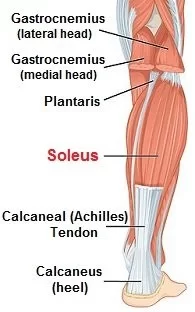
The soleus is a sole-shaped multipennate muscle, which lies deep to the gastrocnemius.
ORIGIN
The soleus muscle has a dome-shaped origin from:
- back of the head and upper one-fourth of the posterior surface of the shaft of the fibula
- soleal line and middle one-third of the medial border of the shaft of the tibia
- the tendinous soleal arch that stretches between the tibia and the fibula.
INSERTION
The tendon of this muscle fuses with the tendon of gastrocnemius to form the tendon Achilles, which is inserted into the middle one-third of the posterior surface of the calcaneum.
NERVE SUPPLY
The nerve supply of the soleus muscle is the tibial nerve (S1, S2).
Blood Supply
The popliteal artery, which splits into the anterior and posterior tibial arteries, provides blood to the muscles of the calf. The posterior tibial artery is the source of the fibular (or peroneal) artery. Through the tarsal tunnel, the posterior tibial artery enters the plantar portion of the foot beside the tibial nerve. Through a break in the interosseous membrane, the anterior tibial artery passes anteriorly between the tibia and fibula. It becomes the dorsalis pedis artery when it travels the whole length of the leg and into the foot.
Lymphatic Drainage
The superficial and deep veins comprise the venous supply of the calf. The larger saphenous vein and the smaller saphenous vein make up the superficial veins. The popliteal vein, anterior tibial vein, posterior tibial vein, and fibular vein are examples of deep veins. The entire lower limb is covered by the longer greater saphenous vein, which is the longest vein in the body. This vein is frequently used by cardiothoracic surgeons for coronary artery bypass grafting. Actually quite large, the little saphenous vein travels along the back of the calf, between the heads of the gastrocnemius muscle, and empties into the popliteal vein most of the time.
The anterior and posterior tibial veins combine to form the popliteal vein. As it enters the femoral region, the popliteal vein changes name to the femoral vein. The knee, ankle, tibiofibular, and a portion of the anterior leg are all drained by the anterior tibial veins. The posterior tibial vein drains the plantar surface of the foot and the posterior muscles of the lower leg by drawing blood from the medial and lateral plantar veins. Blood is transported from the lateral compartment of the leg into the posterior tibial vein by the fibular veins, also referred to as the peroneal veins.
ACTION
The soleus and gastrocnemius act as plantar flexors of the foot, at the ankle joint. The soleus is more powerful than the gastrocnemius but is slower acting than the gastrocnemius. Soleus is chiefly a postural muscle, to steady the leg on the foot.
IMPORTANCE OF CALF MUSCLE
The calf muscles do the work for movements like running, walking, and cycling as they provide the initial propulsion for these movements. Most people train calves for aesthetic purposes. But calf muscle plays a more important role than just to flaunt. The calf muscle is often called the pseudo or periphery heart because of its very important function which is to return the blood from the leg and foot to the heart. Blood flow from the lower body to the heart has to work against gravity, so the contraction of the calf muscle builds up an external pressure that propels the blood through the veins to the heart.
The gastrocnemius muscle is used more during dynamic, higher-force activities and soleus muscle is more active during postural and static contractions. As the gastrocnemius crosses the knee and ankle, the position of the knee during the plantar flexion resistance exercise affects the activity of the muscle. At 90 degrees of knee flexion, the gastrocnemius experiences passive insufficiency and hence, is less active. During calf raise exercise keep the knee 90 degrees flexed to focus on the soleus and zero degrees flexed to focus on the gastrocnemius.
The calves also act as a deceleration tool for the body. While doing a sprint when one needs to stop or change directions quickly the calves absorb up to 10 to 12 times the body weight. Trained calves are therefore required to bear this load and ensure the deceleration takes place safely to avoid injury caused by the eccentric phase of any exercise.
The calves also stabilise the knees which is important for jumping exercises where unstable knees can result in poor form and injury. Here, a strong set of calves protects the joints.
Well-trained calves result in increased vertical jumping power. With the gastrocnemius mainly composed of fast-twitch muscle fibres, the calves can execute quick and explosive movements, such as those required during high jumps, squat jumps, and sprints. Although genetics determine the amount of fast-twitch muscle fibres every person has, strengthening the calves helps everyone perform these power movements.
Embryology
The upper limbs typically develop before the lower limbs. Lower limb development begins in week 4 of pregnancy and is fully differentiated by weeks 8 to 10. Following the lateral plate mesoderm’s mesenchymal cells’ activation, the limb buds begin to form.
Clinical Importance
Thrombosis
Thrombosis may occur from leg vein clots, which may lead to a pulmonary embolus. A cold ischemic leg can happen if the arteries in the lower legs are stenosed or blocked, in which case prompt medical attention is needed to save the leg. The patient may experience a variety of neurological impairments if nerve damage occurs. Prompt fasciotomy is necessary for compartment syndrome, which is a surgical emergency.
When the tissues become hypoperfused due to the elevated pressure inside the compartment, compartment syndrome occurs. Any muscular edema or internal bleeding within the compartment may result in an increase in the pressure inside the compartment because the fascia around it does not extend.
CALF MUSCLE INJURY
When a strain occurs, muscle fibers are torn to some degree.
A pulled calf muscle happens when your internal muscles are overstretched from exercise. This is a common injury, especially among athletes and walkers. Symptoms of a pulled calf muscle can depend on the severity of the injury. A mild strain can leave you with pain and feelings of pulling within the lower half of your leg. You can still walk with a mild strain, but it may be uncomfortable.
Other signs of a pulled calf muscle include:
1. Mild swelling
2. redness
3. bruising
4. inability to stand up on the ball of your foot.
A severe pull in your calf muscles can leave you with feelings of sharp pain. It can also affect your mobility, making you unable to walk. Pulled calf muscles may be chronic from long-term injury or acute from brief over-pulling.
TREATMENT OF CALF MUSCLE INJURY:
A mild calf muscle strain may resolve within a few days. In the meantime, you can use the following home treatments:
1. Ice or cold compresses.
2. Heat pads.
3. Leg wraps.
4. Prop your leg up above your heart level.
5. Rest for at least a full day.
6. Take over-the-counter pain medications.
Surgical Importance
Atherosclerotic plaques are the cause of peripheral artery disease in the lower limbs. The enlargement of atherosclerotic plaques causes claudication, or discomfort when walking. Lower extremity bypass grafting, stenting, and angioplasty are available treatment options.
STRENGTHENING EXERCISE OF CALF MUSCLE
The strengthening exercises of calf muscles are as follows:
1. DOUBLE LEG CALF RAISE
Calf raises are the classic calf-strengthening exercise. They use your body weight to strengthen and tone the gastrocnemius and soleus.
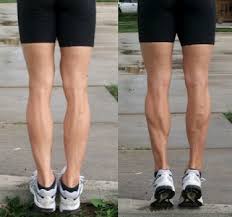
The starting position of the patient is to stand near a wall for balance then place his feet hip-width apart. Now ask the patient to press down into the balls of both feet to raise the body upward. Keep the abdominal muscles pulled in so that the body moves straight upward, rather than shifting it forward or backward.
2. SINGLE LEG CALF RAISE:
The intensity of the calf raise is increased by doing it on one leg. That way one can strengthen the calf muscle even more.
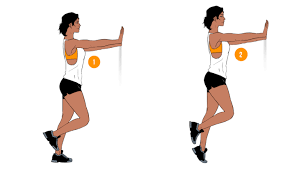
In this, the starting position is to stand on one leg near a wall for balance with the other leg bent. Then press down into the ball of the foot to raise the body upward. Keep the abdominal muscles pulled in to avoid shifting of body forward or backward.
3. SEATED CALF RAISE
One can do this exercise at home also. The exercise works both the gastrocnemius and soleus.
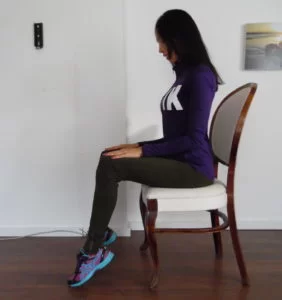
In this, the starting position is to sit on a firm, sturdy chair with the feet flat on the floor. Keep both knees aligned directly over the feet. Don’t let the knees turn in or out. Lean forward placing hands on thighs near knees pushing down to add resistance. Ask to press slowly down into the balls of the feet to raise the heels as high as you can then slowly lower the heels.
4. CALF BUILDING SPORTS
Taking part in sports will help in both strengthening and toning the calves. Running, walking, and hiking are excellent calf-strengthening exercises, especially when one goes uphill. The steeper the climb, the more one’s calves have to work. Running sports such as soccer, basketball, and tennis demand you to run, jump, and push off your calf muscles to accelerate or change direction quickly. So they’re great for toning calves.
STRETCHING EXERCISES OF CALF MUSCLE
1. DOWNWARD DOG POSITION
The key to getting a calf stretch out of this classic yoga pose is to press the heels toward the ground.
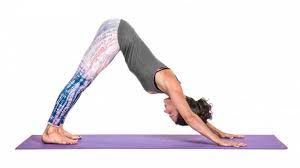
- Start in a high plank with the hands directly under the shoulders.
- Pressing through the fingers and palms, shift body weight back to bring the butt to the ceiling, so the body’s in an inverted V shape.
- Press the heels toward the ground—the closer they get to the floor, the deeper the calf stretch will be.
- To stretch the lower part of the calves, bend the knees slightly while continuing to press the heels toward the ground.
2. SEATED CALF STRETCH WITH RESISTANCE BAND
If a resistance band is not available one can use a yoga strap, a towel, or something similar.
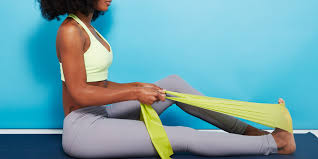
- Sit on the floor with your legs extended.
- Loop a resistance band (or whatever tool you’re using) around one foot, holding both sides of it with the hands.
- Gently pull the toes toward the shin until one feels the stretch in the calf.
- Repeat on the other side.
3. LUNGING CALF STRETCH
A straight back leg means the stretch is going to be in the gastrocnemius, the large muscle of the calf.
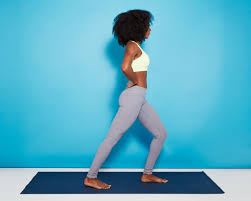
- Stand facing a couple of feet away from a wall. If a wall is not near then one can also just do this with your hand on the hips.
- Place the hands on the wall for support and step one foot back into a mini lunge, bending the front leg and keeping your back leg straight.
- Lean into the wall and press the back heel down so it’s flat on the ground. The further apart the feet are, the deeper the stretch will be.
- Repeat on the other side.
4. HEEL DROP STRETCH
For this stretch, one will need a step, a box, or the edge of a treadmill.
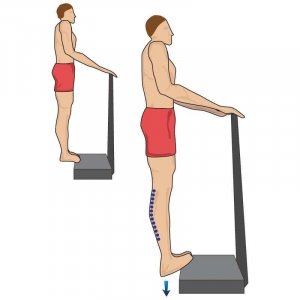
- Stand with the balls of the feet on the edge of the step.
- Drop one heel toward the floor. Bend the other leg and try not to put much weight into it.
- Repeat on the other side.
- To make this a dynamic stretch, one can slowly pedal the heels back and forth, or drop both heels toward the ground and raise them up and down.
5. STANDING BENT-OVER CALF STRETCH
This stretch helps with ankle dorsiflexion.
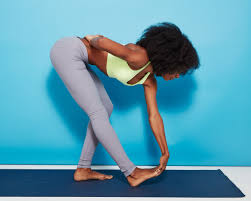
- Stand with the feet staggered.
- Bend the back knee and keep the front knee straight as one folds forward and grabs onto the front foot underneath the toes.
- Pull up gently on the toes, feeling the stretch in the calf.
- Repeat on the other side
FAQs
What is calf muscle?
The posterior region of the lower leg is referred to as the calf (Latin: sura). The gastrocnemius and the soleus are the two biggest muscles in this area. The gastrocnemius, which has medial and lateral heads, is the muscle with the most superficiality.
What is calf muscle pain called?
It’s common to refer to a calf cramp as a “charley horse.” Dehydration or excessive exertion may cause cramps. Even though a cramp only lasts a few seconds, the soreness in your muscle might last for several hours.
What exercise builds calf muscle?
The traditional calf-strengthening exercise is the calf raise. The gastrocnemius and soleus are strengthened and toned using your body weight.
What are other names for calf muscle?
The calf muscle is also known as the triceps surae, which means “three-headed calf muscle.” This is because the gastrocnemius and soleus are joined by a third muscle called the plantaris. The plantaris is a small muscle that is not always present.
What are the 4 calf muscles?
Most of the calf muscles are innervated by the tibial nerve (S1, S2). The gastrocnemius, popliteus, soleus, and plantaris muscles are supplied by branches of the tibial nerve that exit through the popliteal fossa.
How do I relieve calf pain?
Musculoskeletal discomfort can be effectively managed with the use of heat or ice. If your calf trouble is due to an injury, ice is most helpful. If there is no swelling and your symptoms are unrelated to a recent accident, you can try using heat to reduce your pain levels. Never apply cold or heat to your skin directly.

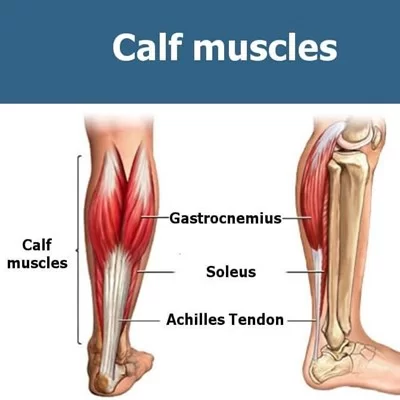
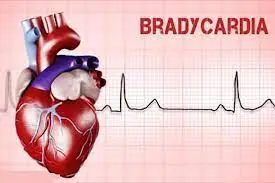
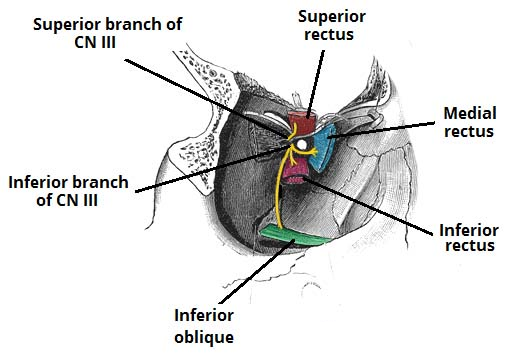

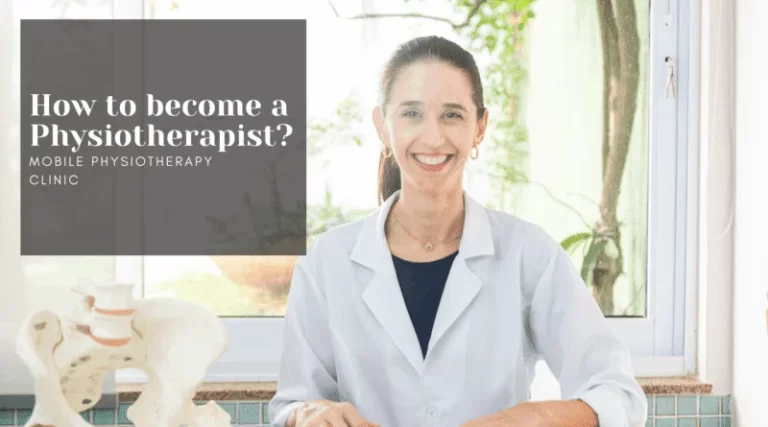
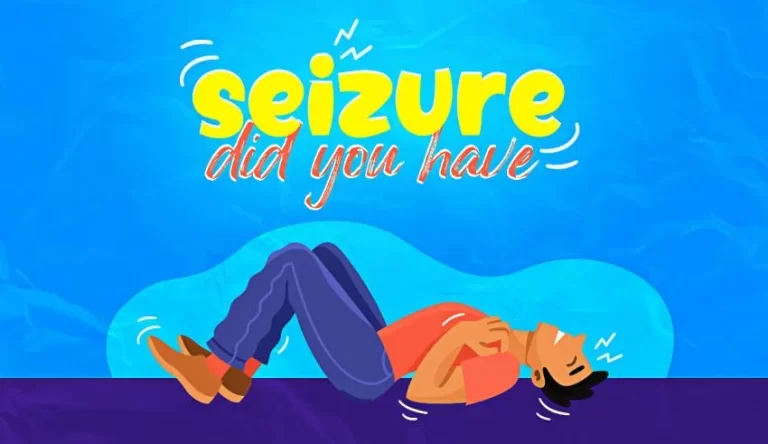
I think both are equally important if you want to strengthen calf muscles at the same time you also focused on proper stretching exercise and regular intervals endurance training, that helps sportsman a lot! For shorter duration sports with high intensity required Bulky calf with proper stretching exercise while Longer duration sports where endurance and proper stretching exercise is more important then Bulky muscles.